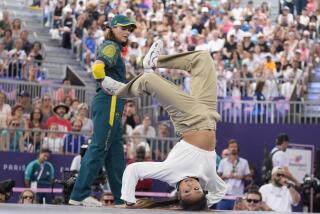WINTER OLYMPICS : IT’S NO SURPRISE : U.S. Performance in Winter Could Be Omen for Summer
CALGARY, Canada — The performance of the United States Olympic team at the Winter Games could have been worse. Before the Opening Ceremony, there were projections that the United States might win no gold medals for the first time ever in the Olympics. The U.S. team exceeded that by two, winning only one fewer gold medal than Finland’s ski jumper, Matti Nykanen.
Besides victories by figure skater Brian Boitano and speed skater Bonnie Blair, U.S. Olympic Committee President Robert Helmick said Sunday he has other reasons to be thankful.
“My main thought leaving in Calgary is that I’m thankful the American public is aware where the United States stands in international competition,” he said.
In the context of the Winter Games, that is considerably above Jamaica and considerably below East Germany and the Soviet Union.
The United States won six medals, which is half as many as it won in 1980 in Lake Placid, N.Y., and two fewer than it won in 1984 in Sarajevo, Yugoslavia. U.S. athletes also were more successful in going for the gold in those Games, winning six gold medals in Lake Placid and four in Sarajevo.
The United States was not particularly successful this year in going for the paper, either. The International Olympic Committee awards diplomas of merit to athletes who finish among the top eight in their events. The United States had 21 top-eight finishes, compared with 36 in Lake Placid and 26 in Sarajevo.
There were some extenuating circumstances, such as the death of speed skater Dan Jansen’s sister, which no doubt accounted for his two falls; the untimely illnesses of speed skater Nick Thometz and figure skater Caryn Kadavy and the injuries to the ski team. As if the skiers had not already had enough bad breaks before they arrived here, Pam Fletcher fractured her leg in a freak accident on the day the women’s downhill was scheduled to be run.
But even if good fortune had been riding with the United States, it probably would not have improved on its performance in Sarajevo. Considering the manner in which Winter Olympics athletes are treated in the United States, that is hardly stunning.
Bonny Warner’s sixth-place finish in the women’s luge is not far short of a miracle considering there is only one luge track in the United States, and it is sub-standard. The U.S. bobsled team, which had a fourth-place finish in the four-man competition Sunday, had to rent bobsled facilities in West Germany before the Games in order to train. There are only three speed skating tracks in the United States. One of them is at the USOC training center in Lake Placid, where there also are luge and bobsled tracks. But athletes there have been housed in a condemned hotel.
“We need to stop for a second and ask if we’re doing everything we can to prepare our athletes,” said Anita DeFrantz, a USOC executive board member and an IOC member from Los Angeles.
That is true not only for athletes in the Winter Games but also for those in the Summer Games. Based on results from world championships in different sports, the United States’ disappointment will extend through the Sept. 17-Oct. 2 Summer Olympics in Seoul, South Korea. A Seoul newspaper recently predicted that the United States will win 31 gold medals, the least since 1936. It predicted 48 for the Soviet Union and 42 for East Germany.
The decline in U.S. athletics has motivated Helmick to appoint an Olympic Overview Commission, chaired by New York Yankees owner George Steinbrenner. The USOC, Helmick said, needs a physical. If it is Helmick’s desire to have someone tell him the diagnosis without mincing words, Steinbrenner is the man.
“You can believe I will look at it tough,” said Steinbrenner, who suddenly is as interested in beating the Eastern Bloc as the Eastern Division of the American League.
No one doubts Steinbrenner’s commitment to athletics or his patriotism. But some USOC executive board members doubt his ability to solve problems without becoming one himself. “George is the prince of the perpendicular pronoun,” said Harold Zimman, an executive board member from Lynn, Mass.
Though Steinbrenner no doubt will be the most visible member of the task force, other appointees, such as former Olympic gold medalist Donna de Varona and Jim Morris, president of the Lilly Foundation in Indianapolis, inspire more confidence. Their charge from Helmick is to determine whether the USOC is getting the most out of its $140 million budget.
With its share of the L.A. Olympic Organizing Committee profits and increased sponsorship funds, the USOC never has had more money. It received $15 million this year from the IOC’s contract with U.S. television networks for both 1988 Games and will receive 10% of the value of future contracts. Helmick said he expects between $50 million and $80 million this year from the sale of commemorative coins, which were authorized by Congress.
Nevertheless, Helmick appealed Sunday for more money.
“Even with our system--our political, social and economic systems--there is no reason we can’t do much, much better (competitively),” he said. “What we’re lacking is the financial support.”
The United States, DeFrantz said, also must develop a better system of identifying athletes at a grass-roots level. Public school systems have done that in the past, but, with less and less money available for athletic programs, the responsibility now rests elsewhere.
“The USOC I don’t think can do it,” she said. “But I would hope that some of our USOC members, such as the Boys Club and YWCA and other organizations, could take a role. They are nationally based and part of the Olympic family. In each community, they serve children, and they serve the country.”
The difference in the East German and the U.S. systems for identifying and developing young athletes is the difference in the histories of Katarina Witt, who successfully defended her Olympic championship Saturday night, and Debi Thomas, who won the bronze medal.
Witt, 22, began figure skating while in kindergarten as part of the government’s nationwide program to introduce children to various sports. By the time she was 10, she had developed to the point that she began training with Jutta Mueller, the best-known coach in East Germany. But Mueller said last week that, even if Witt had not become an elite skater, she would have been able to enjoy the sport recreationally for the rest of her life. Her parents were never asked to pay for lessons, equipment or any of the other expenses associated with figure skating.
Thomas, 20, also began figure skating as a 5 year old, but it was not because anyone directed her toward the sport. She was inspired after seeing Mr. Frick in an Ice Follies show. When she was 10, she began training in Redwood City with Alex McGowan, who is not one of the country’s more expensive coaches. But her mother is still paying off debts that resulted from a $25,000-a-year enterprise. Last March, less than a year from the Olympics, McGowan was forced to close his rink because he could not afford the insurance.
There are similar stories. Biathlete Josh Thompson sold T-shirts to support himself. Speed skater Eric Flaim said his coach could not afford to accompany him to the world championships. Blair had to practice at 6 a.m. each morning while in school because the rink was too busy the rest of the day.
“The DDR (East Germany) doesn’t sit back and wait for athletes to develop,” DeFrantz said. “I’m not saying we should adopt their system. The United States is built on diversity. I think we can create different ways of doing the same thing.”
That already is happening in Los Angeles. DeFrantz is president of the Amateur Athletic Foundation, which helps finance sports projects for youths in the city. Most recently, the AAF put two local ice hockey clubs together with area rinks and the L.A. Kings to develop a program for youths in 10 different areas of the city.
The AAF exists because of a $93 million legacy from the L.A. Olympics. Indianapolis has a similar program because of its legacy from the 1987 Pan American Games and an endowment from the Lilly Foundation. DeFrantz said other cities should follow, not only to develop elite athletes but to provide recreational outlets for children.
“If we’ve made a mistake, it’s been in assuming that everything is going to work out,” she said. “We’ve got to do something now.”
More to Read
Go beyond the scoreboard
Get the latest on L.A.'s teams in the daily Sports Report newsletter.
You may occasionally receive promotional content from the Los Angeles Times.






